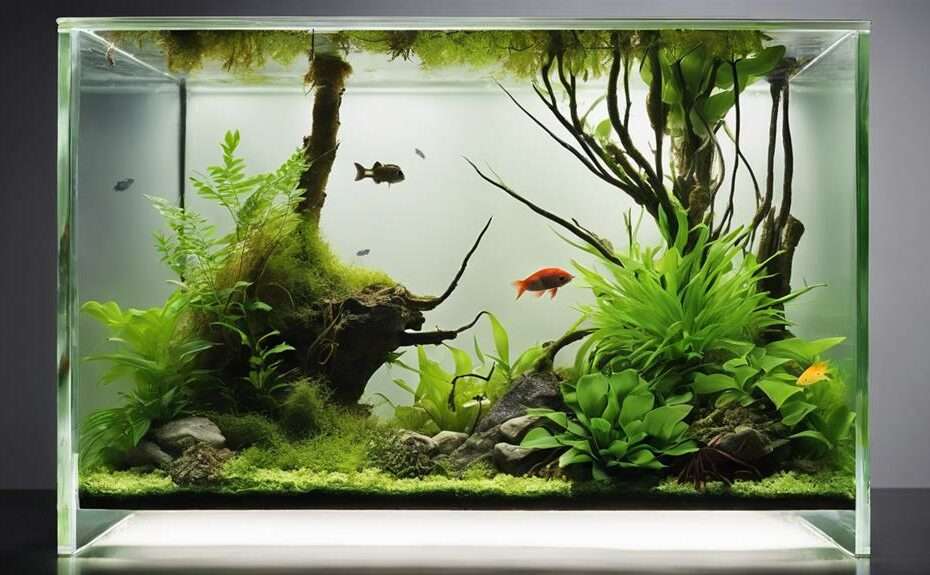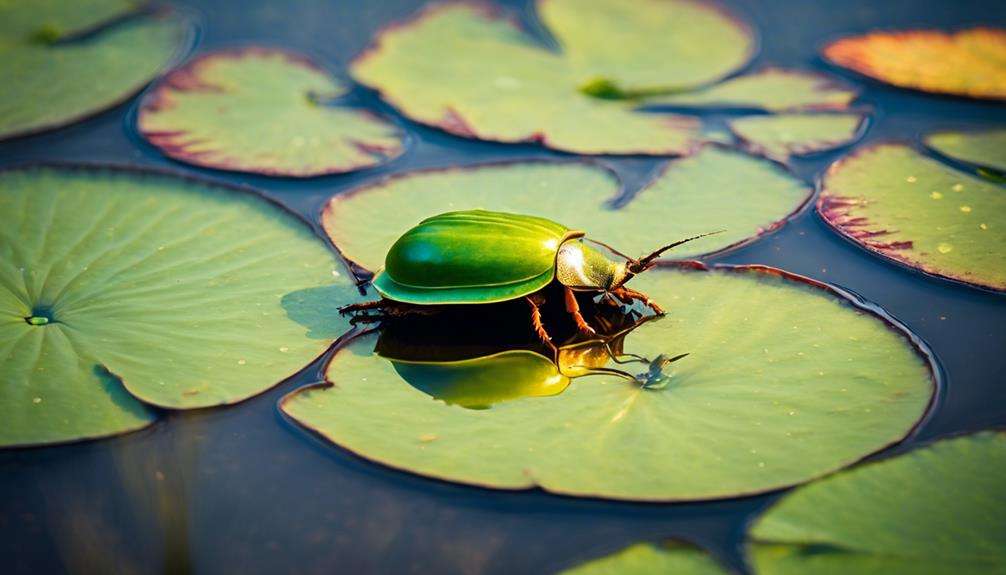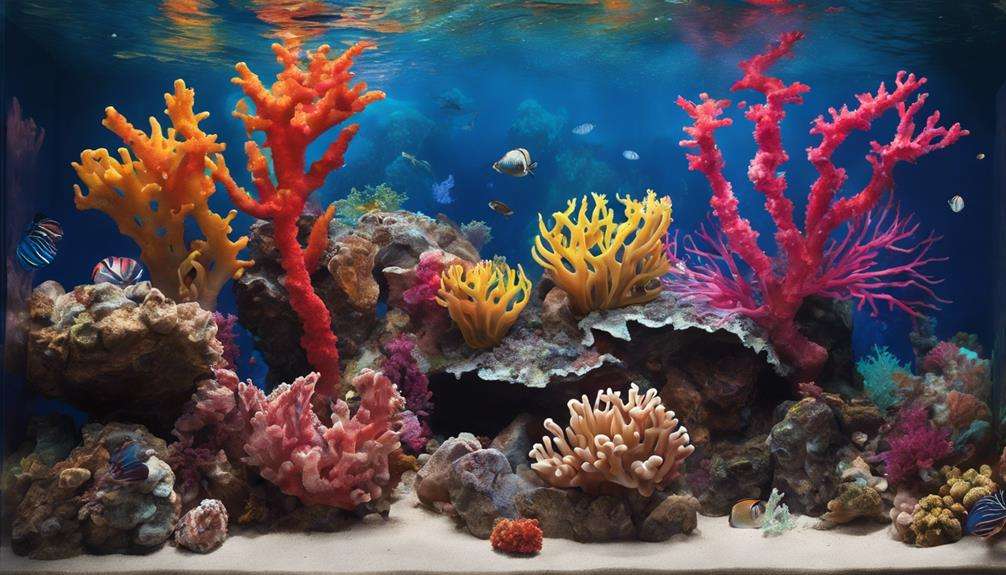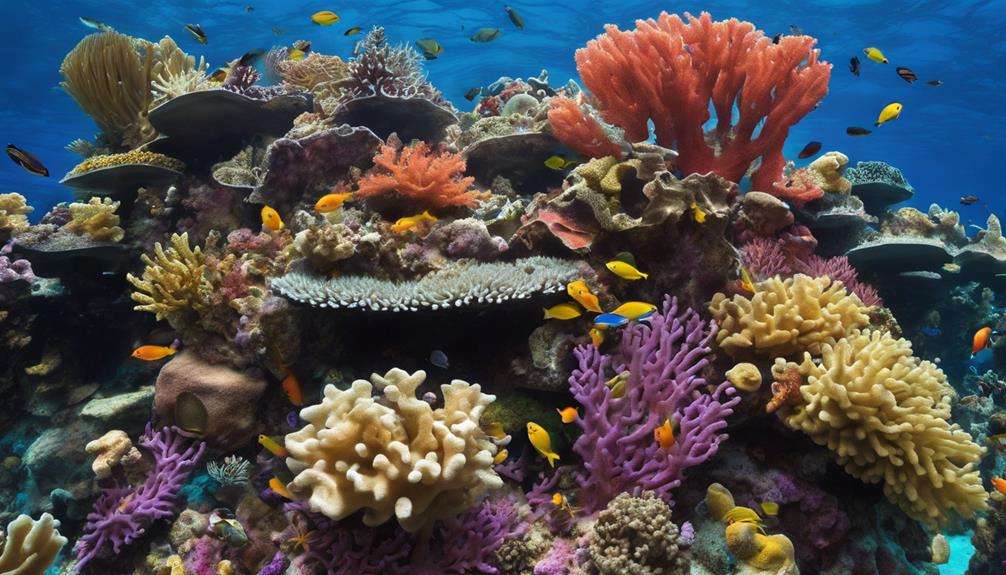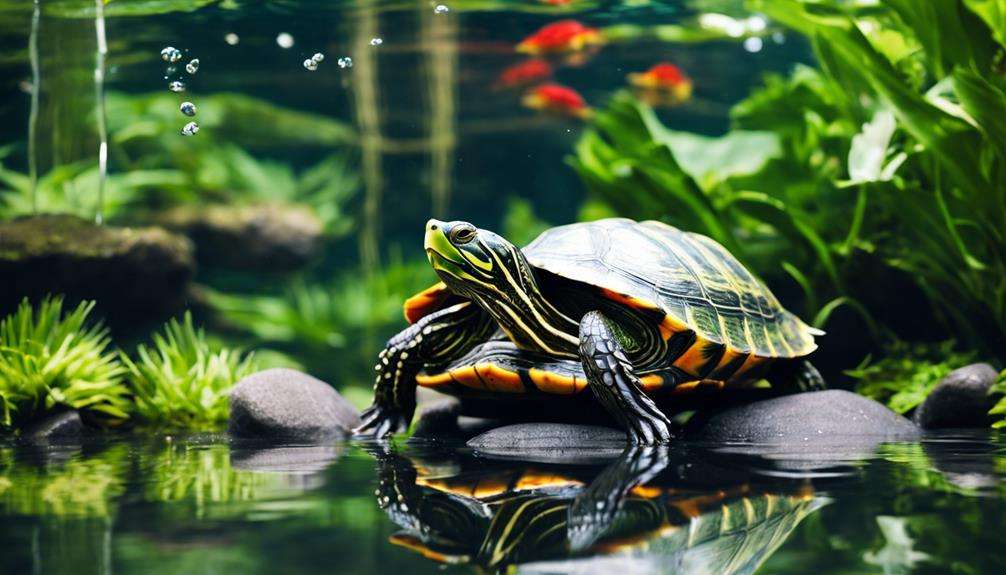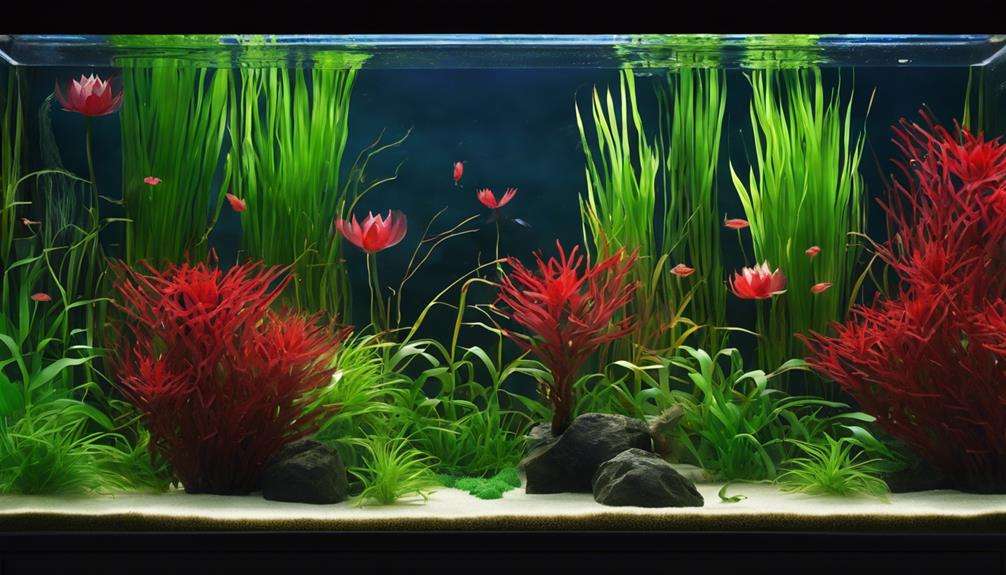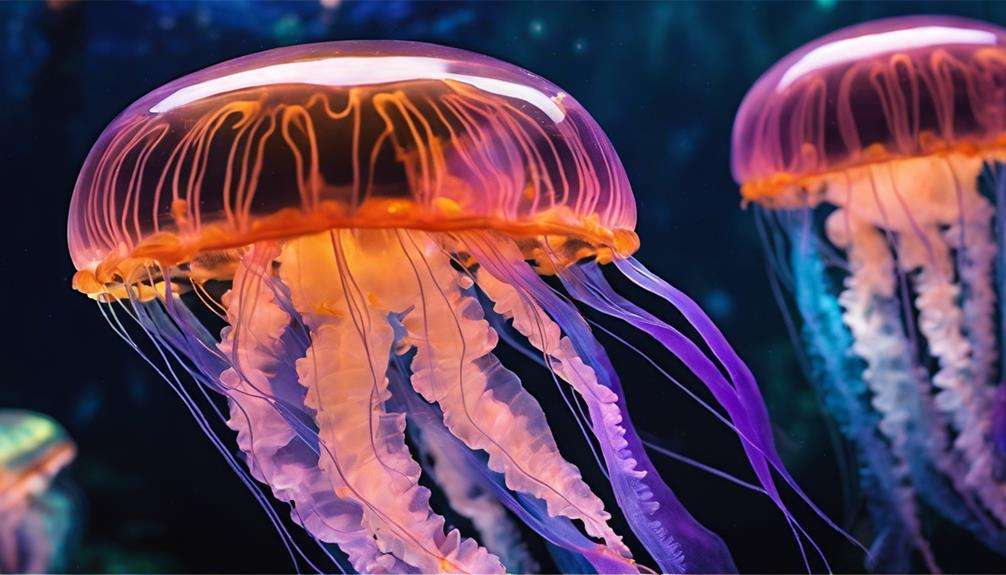Did you know that over 60% of pet owners consider creating a paludarium for their aquatic pets?
The allure of blending land and water in a mesmerizing habitat is not only visually stunning but also beneficial for your aquatic companions.
Imagine providing your pets with an environment that mimics their natural surroundings and promotes their well-being.
Discover how a paludarium can offer a mesmerizing space where your aquatic friends can thrive and explore a world that bridges two ecosystems seamlessly.
Key Takeaways
- Paludariums offer enriching environments for aquatic pets, promoting behavioral stimulation.
- Design tailored habitats with balanced ecosystems for pets' well-being.
- Choose suitable tanks with secure lids and efficient filtration systems.
- Maintain paludariums with regular care, monitoring water quality and plant growth.
Benefits of Paludariums for Aquatic Pets
Paludariums provide aquatic pets with a unique and enriching environment that combines both land and water spaces to cater to their diverse needs. This setup offers a naturalistic setting that mirrors the wild, fostering behavioral enrichment and mental stimulation for aquatic pets.
Within paludariums, aquatic pets have access to various microhabitats, encouraging exploration and the display of natural behaviors. The integration of water and land areas in paludariums supports a more extensive range of plant and animal species, creating a dynamic ecosystem that benefits aquatic pets.
These environments also promote a balanced and self-sustaining ecosystem, contributing to the overall health and well-being of the aquatic pets residing within them. By simulating a habitat that closely resembles their natural surroundings, paludariums offer a holistic approach to caring for aquatic pets, ensuring they thrive in a setting that caters to their physical, mental, and behavioral needs.
Designing a Suitable Habitat for Pets
To create a suitable habitat for your aquatic pets in a paludarium, it's important to tailor the design to meet their specific needs, ensuring a balanced environment that supports their well-being. When designing the habitat, consider incorporating both aquatic and land areas to cater to the diverse needs of your pets. Aquatic pets require access to water for swimming, while land areas are essential for basking and exploration. It's essential to provide a variety of spaces within the habitat to mimic the natural environment of your pets' species accurately.
In addition to incorporating land and water spaces, make sure that the ecosystem within the paludarium is balanced. Choose suitable plants and animals that coexist harmoniously and contribute to the overall well-being of your pets. By creating a balanced ecosystem, you can promote a thriving habitat that supports the health and happiness of your aquatic pets.
Mimicking natural environments in the design of the paludarium will further enhance the quality of life for your pets, encouraging natural behaviors and creating a fulfilling living space.
Paludarium Tank Selection Guide
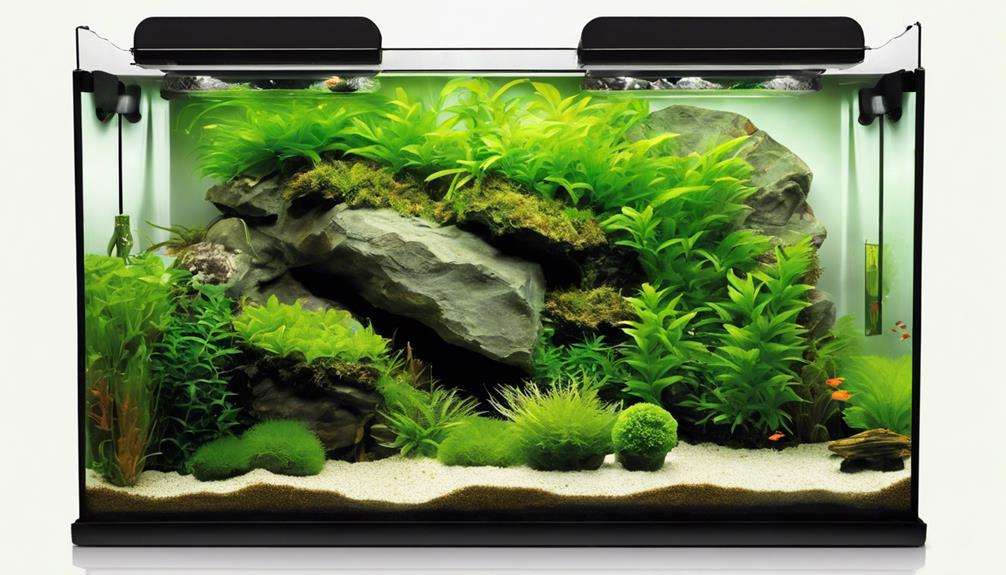
When selecting a tank for your paludarium, prioritize choosing the appropriate size based on the number and size of your aquatic pets. The tank should provide enough space for both aquatic and land-dwelling creatures to thrive.
Make sure the tank comes with a secure lid to prevent any potential escape of land animals and to help maintain the required humidity levels within the paludarium.
Look for tanks equipped with efficient filtration systems to guarantee ideal water quality for your aquatic pets. Opt for a tank with ample height to accommodate various levels of the habitat, including underwater and above-water elements.
It's essential to choose tanks made of durable materials such as glass or acrylic to ensure longevity and ease of maintenance. By selecting a tank that meets these criteria, you can create a suitable environment for your aquatic pets within the paludarium.
Essential Supplies for Paludarium Setup
For ideal plant growth and habitat creation in your paludarium, necessary supplies such as substrates, hardscape materials, lighting fixtures, a filtration system, and heating elements are essential.
Substrates like aqua soil or aquatic plant substrate provide necessary nutrients for plant growth and anchor roots securely.
Hardscape materials such as driftwood, rocks, and branches not only enhance the aesthetic appeal of your paludarium but also create natural habitats for animals to explore and hide.
Lighting fixtures, such as LED lights or fluorescent bulbs, are important for promoting photosynthesis in plants, ensuring they thrive in your ecosystem.
A reliable filtration system is needed to maintain water quality and clarity, removing waste and toxins to create a healthy environment for your aquatic pets.
Additionally, heating elements like heaters or heat mats help regulate the temperature, creating a comfortable habitat for both aquatic and terrestrial inhabitants in your paludarium.
Choosing the Right Substrate and Soil
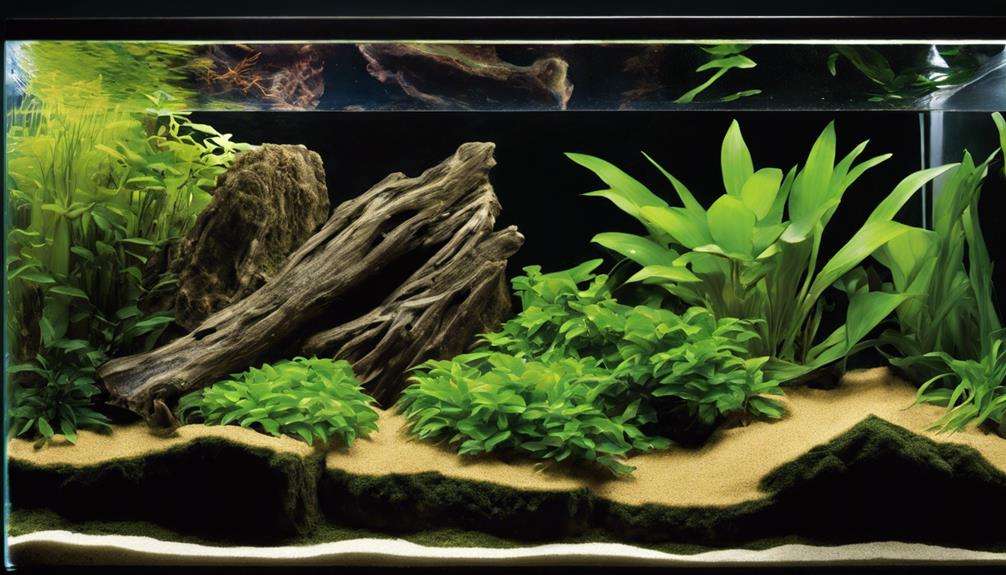
To guarantee ideal plant growth and habitat suitability in your paludarium, selecting the right substrate and soil is essential.
The substrate in the water area plays a vital role in maintaining water quality and supporting aquatic plants. For the best plant growth, consider using nutrient-rich soils like aqua soil, which provide essential nutrients for aquatic plants to thrive. In contrast, sand or gravel substrates are perfect for the water area as they're easy to clean and maintain.
When it comes to the land section, materials like peat moss or coconut fiber can help retain moisture, creating a suitable environment for plants requiring higher humidity levels. To make sure proper drainage and prevent waterlogging, incorporating gravel or clay pellets into the substrate is recommended.
Incorporating Hardscape Elements in Paludarium
Incorporate rocks, branches, and driftwood strategically to enhance the natural habitat and aesthetic appeal of your paludarium. These hardscape elements aren't just for visual appeal; they play important roles in the ecosystem of your paludarium.
Rocks provide climbing surfaces for animals and can influence water flow patterns, creating areas of calm and turbulence. Branches and driftwood offer hiding spots and perches for creatures, while also affecting plant growth by providing anchor points for roots and influencing light exposure.
By carefully arranging these elements, you can regulate the ecosystem within your paludarium, promoting a healthy balance of flora and fauna. Additionally, the landscaping created by rocks, branches, and driftwood can greatly enhance the overall aesthetic appeal of your setup, mimicking natural habitats and creating a visually pleasing environment for both you and your aquatic pets.
Ideal Plants for Paludarium Environment

Enhance the biodiversity and visual appeal of your paludarium by carefully selecting and incorporating ideal plants suited for its unique aquatic and terrestrial environment. For the aquatic section, consider Java Moss, a low-maintenance floating plant that provides cover for aquatic inhabitants. Salvinia is another excellent choice, as it helps control algae growth while adding a natural aesthetic to the water surface.
In the terrestrial section, ferns are a great option due to their ability to thrive in humid conditions and add greenery and texture to the environment. Orchids and bromeliads are popular for their vibrant colors and unique shapes, enhancing the overall look of the paludarium. If you have a spacious setup, consider incorporating mangroves for their unique root systems and ability to grow in brackish water, contributing to the natural ecosystem of your paludarium.
Selecting Animals for Your Paludarium
When selecting animals for your paludarium, focus on species that can thrive in both aquatic and terrestrial environments. Consider adding frogs, turtles, or salamanders to create a diverse and balanced ecosystem within your setup.
Remember to choose bioactive crew members to assist with cleanup and nutrient cycling for a healthy habitat.
Aquatic Species Selection
Consider selecting semi-aquatic animals like frogs, turtles, and salamanders as well as fish species such as Killifish, mollies, and danios for your paludarium to create a diverse and balanced ecosystem. These semi-aquatic creatures will thrive in the paludarium's unique environment, contributing to its biodiversity.
To maintain ecosystem balance, include natural cleaners like Amano Shrimp and ghost shrimp. Enhance biodiversity further by adding freshwater snails, fiddler crabs, and springtails.
Habitat Compatibility
To guarantee a harmonious coexistence among the aquatic and semi-aquatic species in your paludarium, careful selection of animals that can adapt to both aquatic and terrestrial environments is paramount. When selecting species, consider their compatibility, ensuring they contribute positively to the habitat's health.
Choose a variety of animals that fulfill different roles within the ecosystem, such as controlling algae, managing waste, or interacting beneficially with other inhabitants. Understanding the behaviors and care requirements of each species is essential for maintaining a balanced ecosystem.
Maintenance Tips for a Healthy Paludarium
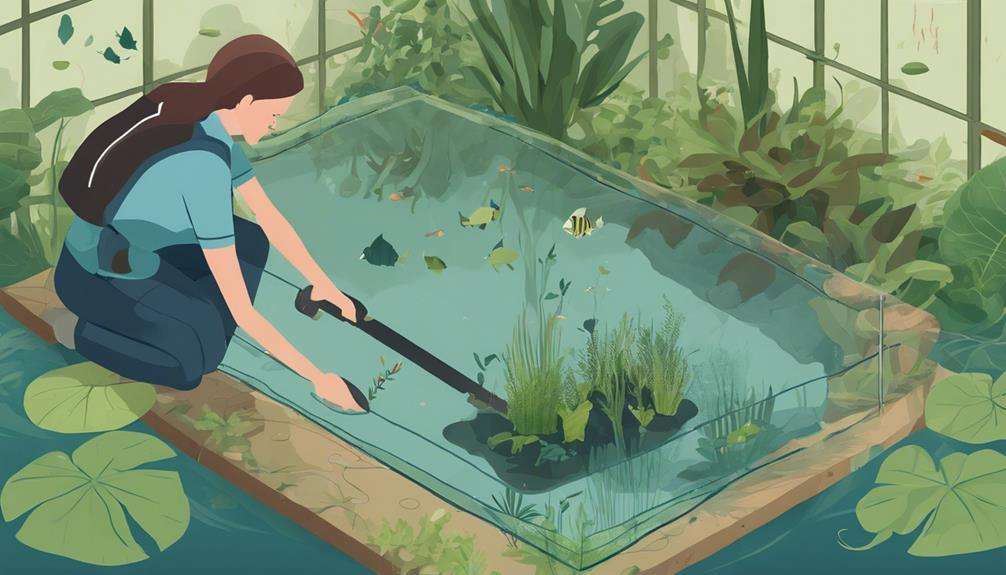
To maintain a healthy paludarium, regularly check water quality to guarantee ideal conditions for your aquatic pets.
Trim and prune plants strategically to prevent overcrowding and maintain a balanced ecosystem.
Keep a consistent lighting schedule to support the growth of plants and provide the necessary environment for both aquatic and terrestrial inhabitants.
Water Quality Checks
Regularly testing water parameters such as pH, ammonia, nitrite, and nitrate levels is essential to maintaining a healthy environment for your aquatic pets in the paludarium. Monitoring pH levels helps guarantee the water is within the suitable range for your pets' well-being. Keep an eye on temperature fluctuations to prevent stress on the inhabitants and maintain stable conditions.
Performing partial water changes is vital to remove waste and replenish nutrients. Utilize water conditioners and beneficial bacteria additives to support the nitrogen cycle, promoting a balanced ecosystem. Watch for changes in water clarity and odor, as these can indicate potential issues affecting your pets' health.
Ensuring ideal water quality is key to fostering a thriving paludarium environment.
Plant Trimming Techniques
Maintain a balanced ecosystem in your paludarium by regularly trimming overgrown plants using sharp, clean scissors or pruning shears.
Trim plant leaves and stems effectively to prevent overcrowding, allowing light and nutrients to reach all plants. Removing dead or decaying plant matter is important to prevent water contamination and maintain water quality within the paludarium.
By trimming plants, you encourage growth and guarantee a healthy environment for your aquatic pets. Monitor plant growth patterns closely and adjust trimming frequency based on the specific needs of the plant species present in the paludarium.
Proper plant maintenance through trimming plays an important role in sustaining the overall health and balance of your paludarium ecosystem.
Lighting Schedule Importance
Properly scheduling lighting in your paludarium is essential for maintaining a healthy ecosystem for your aquatic and terrestrial plants. A well-planned lighting schedule supports best plant growth and photosynthesis by providing balanced light exposure.
Mimicking natural day-night cycles helps regulate plant behaviors and maintain ecosystem balance. LED lights are a popular choice due to their energy efficiency and customizable settings, allowing you to cater to specific plant requirements.
However, it's critical to monitor light intensity and duration to prevent issues like algae overgrowth and safeguard the well-being of your pets. Inadequate or excessive lighting can disrupt the delicate balance of your paludarium, causing stress to its inhabitants.
Frequently Asked Questions
What Is the Purpose of a Paludarium?
The purpose of a paludarium is to replicate natural habitats by combining land and water elements. It enhances plant growth, maintains water quality, regulates humidity levels, provides land area, influences animal behavior, offers aesthetic appeal, and promotes environmental enrichment.
Are Paludariums Hard to Maintain?
Balancing aquatic and terrestrial domains, paludariums demand meticulous care. Monitor water quality, humidity, plant growth. Guarantee proper lighting, heating, filtration for pet well-being. Attention to detail surpasses aquariums/terrariums. Research plant/animal needs for maintenance success.
What Pets Are Good in a Paludarium?
For frog species, consider dwarf frogs or tree frogs. Turtle types like mud turtles or map turtles thrive. Fish options include guppies, tetras, and rasboras. Insect varieties could be stick insects or beetles. Plant selection is vital for amphibian choices. Reptile species like anoles or geckos also fit well. Crustacean options include fiddler crabs or cherry shrimp.
What Is the Difference Between a Paludarium and an Aquarium?
In a paludarium, the design includes distinct land and water areas, offering a diverse ecosystem. Water levels, plant placement, substrate options, lighting, temperature, humidity, and feeding habits vary from aquariums, creating a dynamic environment for your pets.
Conclusion
To sum up, creating a paludarium for your aquatic pets can provide numerous benefits, including a more natural and enriching environment.
By carefully designing the habitat, selecting suitable plants and animals, and maintaining a balanced ecosystem, you can guarantee the health and happiness of your aquatic companions.
Remember, when it comes to paludariums, the early bird catches the worm, so start planning and enjoy the rewarding experience of creating a dynamic and engaging space for your pets.
